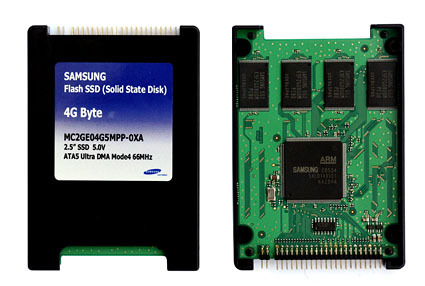Samsung announces 40 nm Flash, predicts 20 nm devices
Seoul (Korea) - There's still room left for NAND Flash to scale. According to Samsung, the technology may shrink into 20 nm structures, down from the common 70 and 60 nm today. Samsung also presented the memory it will position to replace NOR Flash: Phase-change Random Access Memory (PRAM) promises a 30x increases in speed and 10 times the life span of flash.
Samsung holds a very comfortable lead in the global NAND flash market - according to market research firm Isuppli a share of 46.2% in Q2 of this year - and the Korean manufacturer continues to accelerate the development of the technology which aims to move beyond MP3 players and memory cards. Current Flash memory sticks are topping out at a capacity of 16 GB, but Samsung believes that we'll be seeing devices with well more than 100 GB space in the future.
The company today announced the first 40 nm, 32 Gb(it) chip, which will enable memory card manufacturers to assemble 64 GB SD or Compact Flash cards - which could store 64 GB card can store over 64 hours of DVD resolution movies or more than 15,000 MP3 music files. Key to the capacity increase is a new approach that Samsung calls "charge trap technology." Compared to the currently manufactured NAND flash - which was introduced by Toshiba in 1989 - uses a metal single-gate structure that is significantly smaller than the usual poly-silicon dual-gate. Samsung claims that the technology will allow the manufacturing of 256 Gb chips in 20 nm, while dual-gate flash chips will top out at 16 Gb and around 50 nm.
"NAND" is used today in applications where data needs to be written to the flash chip. For example, the technology is used in digital cameras, USB sticks and MP3 players such as Apple's Ipod Nano. Samsung hopers that NAND flash will also make its way into PC applications with the release of Windows Vista - which will be able to speed up software by taking advantage of flash memory in hybrid hard drives, solid state disks as well as external flash devices. 20 nm flash chips could pave the way to MP3 players and storage cards with 128 and potentially 256 GB capacity by the end of this decade.

Flash memory will soon be available in mainstream solid state disks, such as this sub-$200 4 GB flash drive.
"NOR", which is used when data is only read from flash memory - such as memory chips that contain fixed operating systems, may run into natural limits earlier than NAND. Samsung believes that a new technology could replace NOR within a decade - and the company bets that it will be Phase-change Random Access Memory (PRAM). The firm said that PRAM is about 30 times faster than NOR and offers ten times the number of read/write cycles. A first prototype developed by the company has a cell size 0.0467μm2. Samsung claims that PRAM offers a "virtually" unlimited scalability." First devices based on the technology are expected to be available as 512 Mb chips sometime in 2008.
Related articles:
Samsung readies 4 GB flash drive for Windows Vista PCs
PQI to ship 64 GB 2.5" SATA flash disk in August
Samsung launches 32 GB Flash disk for mobile computers
Intel, Micron challenge Samsung with first 50 nm flash memory
Flash memory could slash boot time of Intel Merom computers by 50%
Get Tom's Hardware's best news and in-depth reviews, straight to your inbox.
Tom's Hardware is the leading destination for hardcore computer enthusiasts. We cover everything from processors to 3D printers, single-board computers, SSDs and high-end gaming rigs, empowering readers to make the most of the tech they love, keep up on the latest developments and buy the right gear. Our staff has more than 100 years of combined experience covering news, solving tech problems and reviewing components and systems.